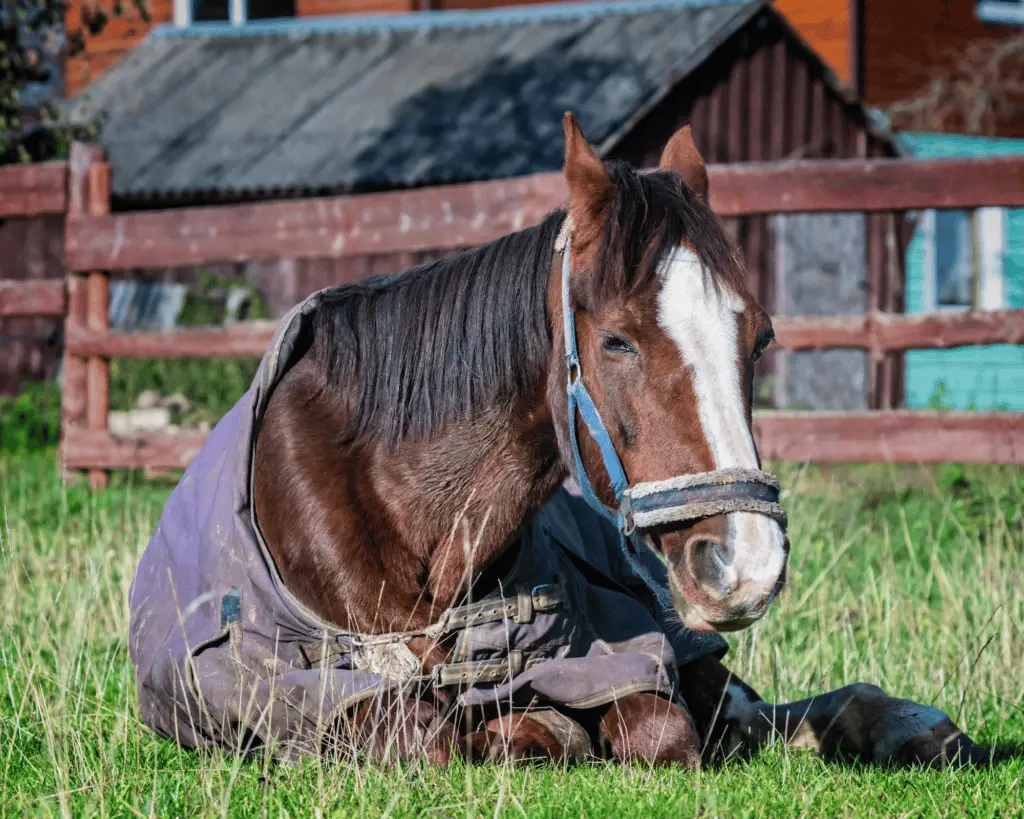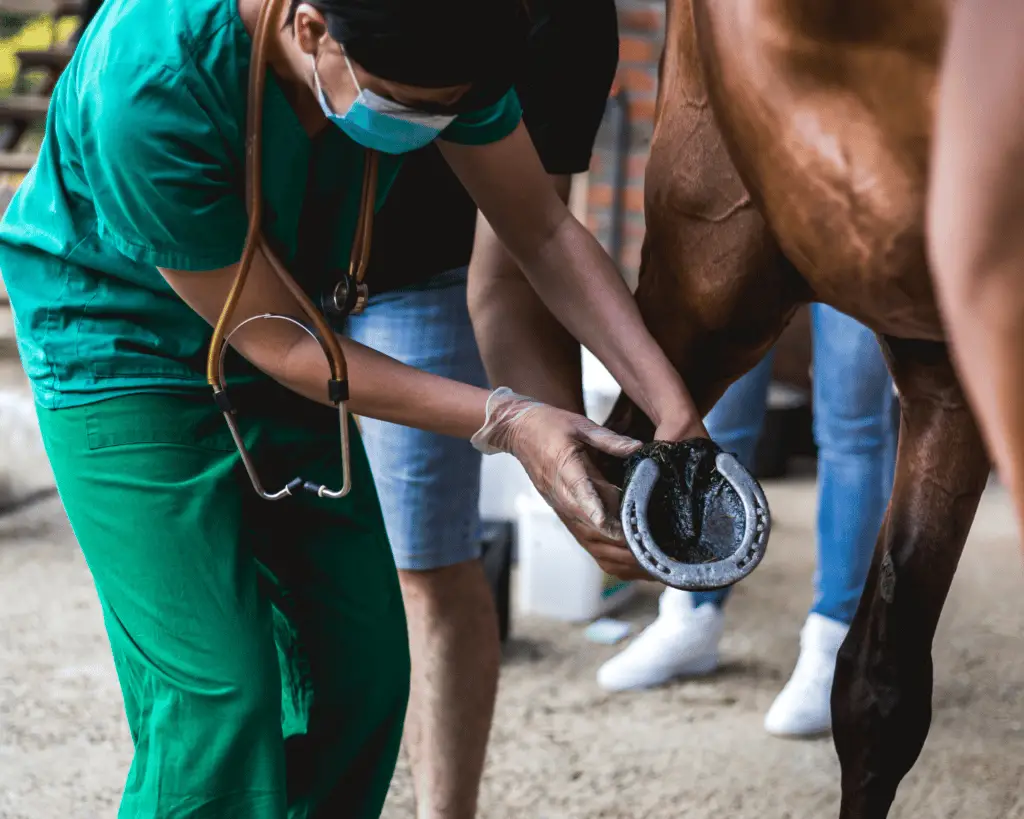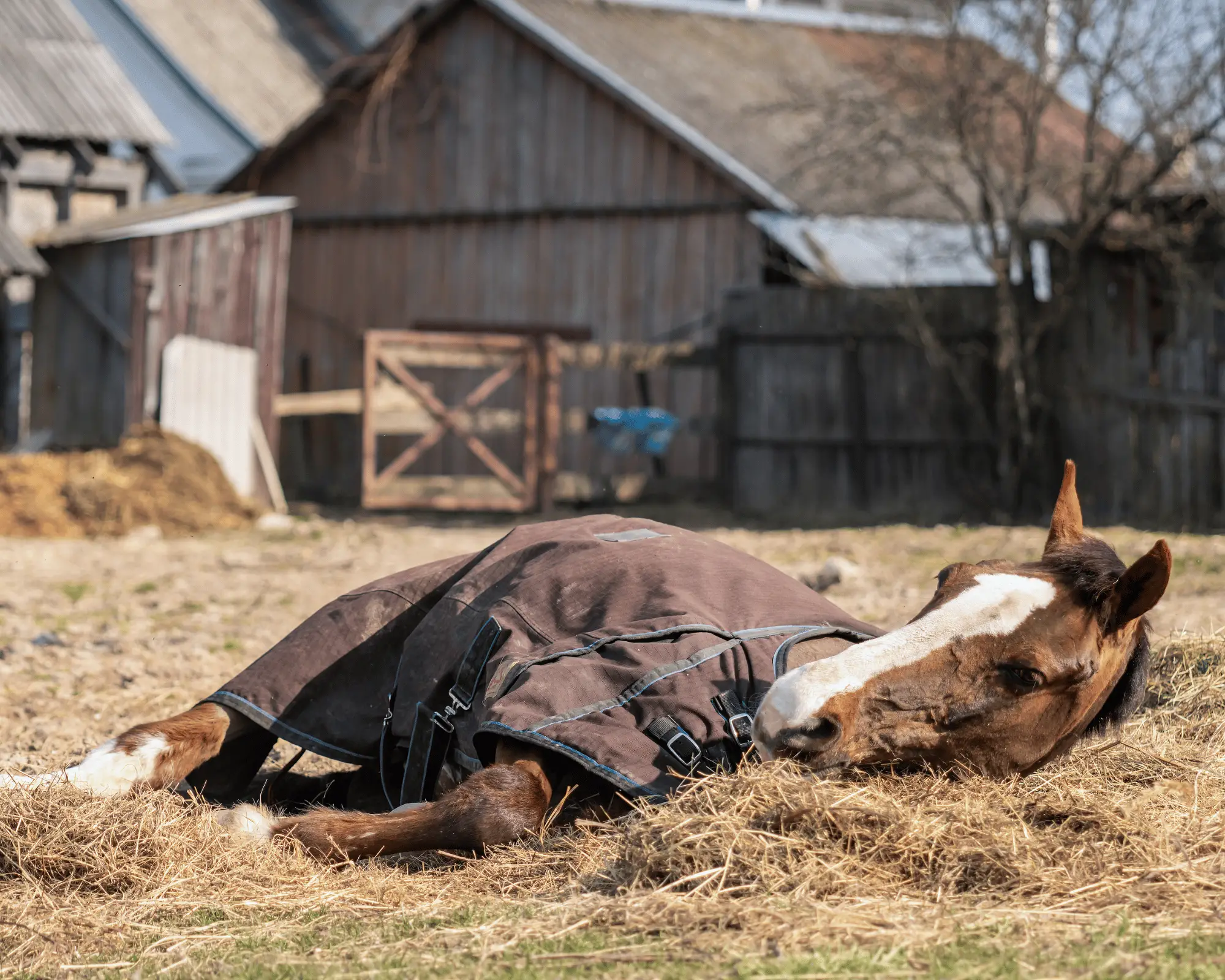Laminitis is a hoof disorder that highlights just how fragile a horse can be. It’s not something that’s always fatal, and a horse can live a long time with the condition—provided they get aggressive care during the acute phase, proper hoof care, and the right diet. However, once a horse has gone through laminitis, it’s prone to dealing with the condition for the rest of its life. On the other hand, a horse can have a case of laminitis so severe that it won’t be able to survive and requires euthanasia.
How do you know when to euthanize a horse with laminitis? Sometimes the answer is clear, and sometimes it’s not. Your veterinarian can help you decide if it’s time to release your horse from its pain, or if there’s still hope for a good quality of life.
What is Laminitis?
Laminitis is a hoof condition that involves damage to the tissues that support the coffin bone inside the hoof. It occurs when there’s a disruption of blood flow to the hoof from a metabolic condition or ingestion of a toxic substance. Once the process has started, it has to be addressed immediately to prevent further progression. If no treatment is sought or provided, the coffin bone can rotate downwards and penetrate the sole of the hoof.
The laminae are layers of folded tissue that run parallel to the coffin bone and connect the coffin bone to the wall of the hoof. They rely on a regular supply of blood flow to do their job properly. When the blood supply suffers a disruption, the laminae become damaged and allow the coffin bone to sink or rotate downwards. The tip of the bone goes down while the heel goes up.
Rotation is the end stage of laminitis, known as founder. A horse can have laminitis, but not have rotation (even though the two names are used interchangeably).
The exact mechanism of laminitis is unknown, but the causes are definitive. Horses that are at risk of laminitis are those that have Cushing’s, have gorged or grain or sweet feed, have eaten lush grass full of sugar, or have been run on asphalt for an extended period of time.
You should always work with your vet if and when your horse is sick or injured, but educating yourself about your horse’s diagnosis can help you do your part to properly care for your horse.
Signs and Symptoms of Laminitis
A horse that’s starting laminitis usually doesn’t show signs of distress right away. Laminitis is a metabolic condition and requires time for the body to discover that it can’t process an overload of sugars or shock (from excessive impact on asphalt). This is why it’s important to start treatment for laminitis the moment you discover your horse has gotten into the grain or they walk tenderly after riding on asphalt.
Once the damage to the laminae begins, the horse starts to exhibit signs of pain in its front feet. The classic signs of laminitis are heat in the hoof and crouching backward to take the weight off the front feet. Laminitis typically affects the front hooves, but the rears can be affected as well. A horse may lay down frequently, be reluctant to stand up, shift from leg to leg, and may not let you pick up its feet.
Common signs of laminitis include:
- Lameness, especially when turning in circles
- Shifting weight
- Heat in the hoof
- Increased pulse in the hooves
- Tiptoeing gait
- Pain in the toe region when testers are used

Does it Cause Pain in Horses?
Yes, laminitis causes pain in horses. The loss of blood flow to the laminae and the resulting tissue death results in pain levels that range from mild soreness to level 10 pain in a horse, depending on the severity of symptoms.
How Long Can a Horse Live With Laminitis?
A horse can live a full life with laminitis provided they receive prompt treatment that restores blood flow to the hoof. Acting quickly can prevent or minimize rotation, and enable the horse to recover quickly. After proper veterinary care and shoeing have been provided, and the horse has been allowed to recover and heal, it can live a long, full life with proper dietary management.
A horse who has suffered a 15-degree or higher rotation has a poor prognosis, and may never be able to return to work. You may be faced with the need to euthanize your horse as its quality of life will never improve to a point where it can be comfortable moving around.
Can You Ride a Horse With Laminitis?
The ability of a horse to return to work has to be determined after the episode has passed and the hooves are stabilized through shoeing and growth of the outer wall. Ultimately, it depends on how well a horse recovers from a bout with laminitis. Some horses recover nicely from their episode, while others don’t. A horse that has little long-term damage from an episode of laminitis is one that can return to normal life and workload. On the other hand, a horse that doesn’t recover well may still have a working life in the form of riding or driving, but it’s limited to low-impact activities.
Riding a horse after the laminitis phase has passed requires coordinating with the vet and farrier to find out the extent of the damage done to the foot. You may need to wait a while for the hoof capsule to grow out over the coffin bone if there’s rotation. Alternatively, if there’s little to no rotation, you can ride your horse after a reasonable healing period and supportive shoes have been put on.
A horse needs to move in order to pump blood to the hoof. Blood flow helps with healing and tissue support, which means light riding may be called for to help encourage blood flow to the laminae after the vet decides it’s okay to do so.
Treating Laminitis
Much of the initial treatment of laminitis is dependent on how quickly you can respond and administer treatment to a horse once the signs are obvious. The initial onset of laminitis is known as the developmental phase, and there are usually no clinical signs that anything is wrong. Once the condition develops further, it has moved into the acute phase. This is a crucial time for a horse’s ability to recover from the effects of sugar overload and veterinary intervention needs to be sought as soon as possible.
The sooner a horse can be treated by a veterinarian during the acute phase can make all the difference in the outcome. Aggressive treatment can stop the process and restore blood flow to the hoof capsule, minimizing damage to the structures of the hoof.
Steps to Take While Waiting for the Vet
Cold water or ice is the first line of defense against laminitis as it cools down the temperature in the feet and enables blood flow to return. You can use cold water straight from the hose to begin the treatment and have someone prepare a tub with ice and water in the meantime. Once the tub is ready, pick each foot up and stand the horse in the tub for as long as possible.
Prepare a stall with deep bedding to allow your horse to stand on a comfortable surface. Don’t allow them out of the stall until the vet arrives, and do not provide forage or grain—only water. Your vet may have you administer anti-inflammatories and will advise you on how to provide them to the horse if you don’t have an IM or oral paste available.
One home remedy for treating a horse with laminitis is to get a piece of insulation board and a roll of duct tape (or any hard-wearing tape) from the hardware store. Cut the board down into a rough hoof shape, and to a size that’s close to the edge of each hoof. Take the duct tape and wrap the board to the hoof. Keep adding layers as the initial board gets crushed. This serves to support the coffin bone and give a cushion to soften the blow of walking.
Veterinary Treatment
Once the vet arrives, they’ll evaluate the horse to determine its current state and what needs to be done. The vet will most likely administer IV anti-inflammatories to give the horse pain relief and counteract the swelling in the hooves. In the event the laminitis was caused by grain consumption, the vet will insert a nasogastric tube into the horse and pump mineral oil directly into the horse’s stomach. This action flushes out the grain more quickly and prevents further damage.
X-rays are taken to determine if there’s rotation of the coffin bone. Sometimes X-rays aren’t going to reveal the extent of the damage due to the fact the horse is still in the acute phase of laminitis and will be taken later after the acute phase has passed.
Hoof testers are employed by the veterinarian to find areas of sensitivity in the sole, but this isn’t always a definitive test as the entire hoof can be sore and cause the horse to react to pressure. A nerve block may be applied to allow the veterinarian to pick up one leg without the horse fighting through pain to stand upright. The nerve block is also used to uncover gait issues that are the result of laminitis.
Once the veterinarian has done what they can, they’ll leave you with the appropriate medications, a plan of treatment, and a recommendation for the type of shoes that a farrier needs to put on the horse. The vet will also schedule a follow-up visit after the horse has had sufficient time to heal and recover from the episode.
Diet and Shoeing
Diet and supportive shoeing are the most effective methods of treating laminitis once the acute phase has passed and the damage can be assessed. Your horse’s digestive system is going to be tender and sensitive for a period of time and require a diet that’s gentle. Proper shoeing supports the coffin bone as the laminae heal, and also provides the horse with comfort.
A horse that’s in the post-acute stage of laminitis should not be fed anything that contains sugar in any form. That means no sweet feed with molasses and hard feed that contains corn, barley, or oats. If you have a hard keeper, supplement their feed with a cup of vegetable oil throughout their feeding schedule. Keep the horse off fresh grass and put them on a pasture that’s been grazed down. Feed low-quality hay that’s been soaked to help them digest while removing a potential source of sugar. You’ll be able to restore some sugar to their diet as they recover from laminitis.
Shoeing is essential for keeping your horse comfortable and supported as they recover. The farrier shoes the horse in accordance with the presentation of the hoof and the vet’s advice. Some horses may require a full heart bar shoe to support the coffin bone as the laminae heal, or the farrier may opt to put on this type of shoe as a precaution. Another type of shoeing technique for laminitis is to reverse the shoe and take the pressure off the toe for hoof turnover.

How Long Does Acute Laminitis Last?
When treated, the acute phase of laminitis lasts anywhere from one to three days, depending on the severity and the cause. The cause can be addressed quickly, but it can take a while for the toxins to pass through and for the body to respond to treatment.
Can a Horse Recover From Severe Laminitis?
It depends on the severity of the damage to the hoof. As previously mentioned, a 15-degree rotation has a poor prognosis, but the lower the degree of rotation, the better the odds of recovery. Your veterinarian can provide you with better advice and prognosis after the acute phase has passed and the horse starts its recovery process.
Is Laminitis in Horses Fatal?
Laminitis by itself is not fatal, but it does require knowing when to euthanize a horse with laminitis. A horse who has acute laminitis to the point its coffin bones have rotated to or through the sole of the hoof will never recover. If the laminitis is severe enough, the hoof wall can separate from the coronary band and eventually fall off, leaving the coffin bone exposed. The kindest decision you can make at this point is to have your horse put down as soon as possible to end its suffering. Again, you should always make this decision in partnership with your vet.
It’s very hard to accept that a seemingly healthy horse needs euthanasia, but it truly is the best thing you can do when the point of no return has been reached. A horse with severe coffin bone rotation will be unable to survive without pain, and there is no treatment available that undoes the rotation. You can take comfort, scant as it may be, in the fact that you did all that you could for your horse prior to making the decision.


I have signed up and joined the group. Is there any way I can submit x-rays of my mini and her painful laminitis to get trimming advice?
Hi Andrea,
I’m sorry, but unfortunately we are not able to give individualized medical advice for your mini. We recommend sending the x-rays to your vet!
I’m in a tough spot, to euthanize or not to euthanize…I’ve dealt with founder and laminitis for 8 years now and it’s emotionally draining. I just don’t think I can do it anymore, but I do t want to lose my girl it’s a very tough decision.